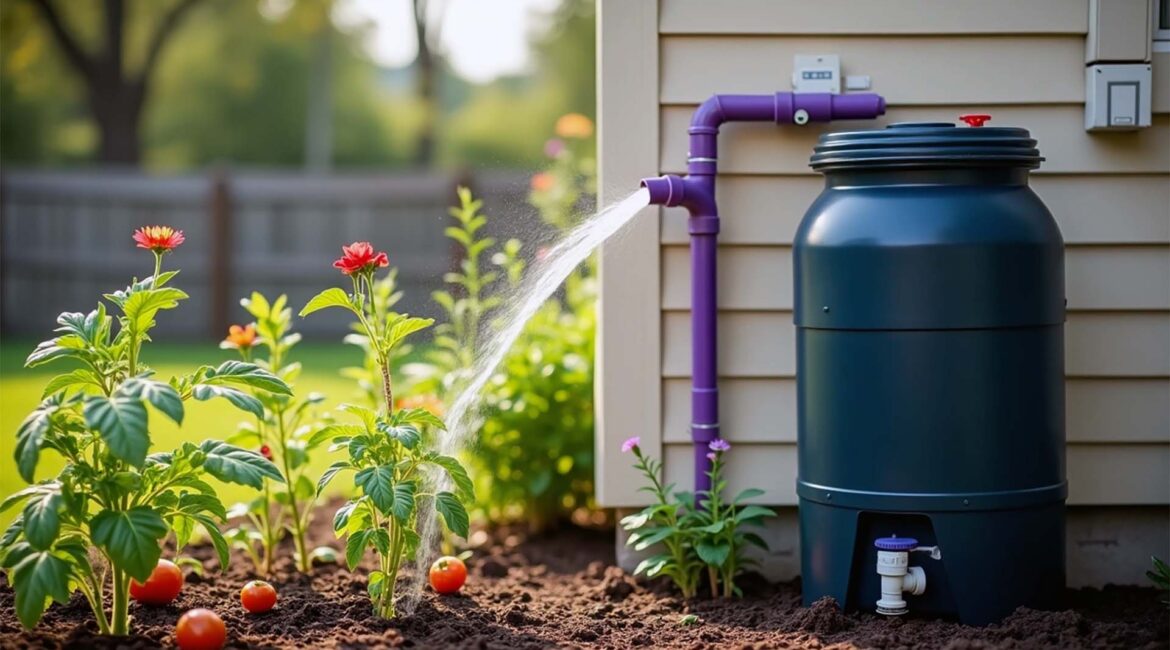Greywater rainwater recycling systems help solve our planet’s growing water crisis. The IPCC’s sixth report (2022) predicts severe environmental challenges by 2050. Water availability in watersheds worldwide could drop between 42% to 79%. These numbers show why water conservation has become crucial for our survival.
Home greywater systems deliver impressive water savings. Households can save 40,000 gallons each year through greywater collection. This reduces their dependence on city water and cuts water bills by up to 40%. Combined rainwater and greywater systems boost urban water security during dry spells. These innovative systems merge rainwater collection with greywater recycling to optimize water use.
They reduce rainwater runoff and provide nutrient-rich water for gardens. Tiny homes already use less energy than regular houses. Adding these systems helps them save thousands of gallons yearly, especially during hot or drought-prone seasons.
Table of Contents
- Understanding Greywater and Rainwater Systems
- Types of Greywater and Rainwater Systems
- Benefits and Practical Applications
- Safety, Maintenance, and Considerations
- Final Thoughts
Understanding Greywater and Rainwater Systems
Water recycling at home uses two different systems that work in unique ways. These innovative approaches save water that would normally go to waste and provide environmentally responsible alternatives for household needs.
What is greywater recycling?
Greywater comes from household water used in showers, baths, bathroom sinks, and washing machines. This includes all wastewater except toilet discharge (blackwater) and sometimes kitchen sink water. A greywater recycling system captures this used water, treats it, and redirects it to non-potable purposes.
The filtration processes in most greywater systems remove impurities and contaminants to make water suitable for reuse. Your household water consumption can drop by 25-45% with these systems, which also reduces wastewater volumes. Safety guidelines recommend against storing untreated greywater beyond 24 hours because bacteria can grow.
How rainwater collection systems work
Rainwater harvesting systems collect precipitation from rooftops and other surfaces. Rain falls on the roof and flows through gutters into a storage tank. The system’s filters remove leaves and debris before storage.
The system’s core components include collection surfaces (roof and gutters), inlet filters, storage tanks, controls, treatment systems, pumps, and backflow prevention devices. Rainwater offers more flexibility than greywater because it stays safe for longer periods when filtered properly. Gardeners can use it whenever needed.
Key differences and similarities
These water conservation systems operate differently. Your greywater system recycles household water continuously, while rainwater systems depend on seasonal precipitation. The water’s composition varies. Greywater contains soaps, detergents, and organic matter that need more treatment. Rainwater comes naturally cleaner and needs less filtration.
Storage options differ between the systems. Greywater needs quick use, but rainwater remains usable for weeks or months. The system costs vary. Rainwater systems cost more upfront due to storage and filtration needs, though greywater systems need more regular maintenance.
These systems create a collaborative effort. Your garden’s sensitive plants and drip irrigation work best with rainwater, while greywater suits hardier perennial plantings, shrubs, and trees. Together, they improve water efficiency throughout your home and garden space.
Types of Greywater and Rainwater Systems
Homeowners can choose from DIY solutions to automated systems when it comes to recycling water. Each system provides unique benefits based on your needs, budget, and property layout.
Simple greywater systems: laundry-to-landscape
The laundry-to-landscape system is the easiest way to start water recycling. This simple setup uses your washing machine’s water to feed your garden without any plumbing modifications. Your machine’s internal pump helps distribute water throughout flat yards and can handle small terrain variations. The installation costs only 5-10% of professional advanced systems, which makes it ideal for beginners or renters.
Branched drain and gravity-fed systems
Branched drain systems cleverly distribute shower and sink greywater through drainage pipes that split the flow into smaller paths. These systems run entirely on gravity without pumps, filters, or storage tanks. They require a careful design with a 2% downward slope, but they can last for decades with minimal upkeep. Trees benefit most from these systems compared to smaller plants.
Advanced greywater recycling systems
Pumped systems give you more options for complex layouts or wider uses. These installations typically include filtration stages and sometimes disinfection processes. Advanced models can make greywater suitable for toilet flushing, cleaning, and laundry through multi-stage filtration.
Rainwater harvesting systems for homes
Home rainwater systems come in various forms, from above-ground solutions with downhill placement to underground storage. Rooftops collect the water, which flows through gutters into storage tanks. More advanced setups use filtration and disinfection to expand water usage beyond just irrigation.
Hybrid systems combining both sources
Hybrid rainwater/greywater systems represent state-of-the-art water recycling technology. These blended solutions can reduce potable water usage by up to 42.5% yearly. The combination provides a reliable water supply throughout the year by using rainwater in wet seasons and greywater during dry spells.
Benefits and Practical Applications
Greywater and rainwater recycling systems offer clear benefits that go beyond helping the environment. Homeowners looking for eco-friendly options without giving up convenience find these practical advantages appealing.
Water conservation and reduced utility bills
Homes with detailed greywater systems can cut their water usage by about 50%, which could mean paying only half the usual water bills for metered customers. Simple systems that reuse bath and shower water for toilets can reduce water use by up to 30%. The system pays for itself in three to seven years, based on how much water you use. These recycling systems make sense both for the planet and your wallet.
Using greywater for garden irrigation
Garden irrigation is the easiest way to use greywater. The soil filters out contaminants naturally, and some residues can work as mild fertilizers. Your greywater system works best when you move the water distribution points around to avoid saturating the soil and use mulch to spread water evenly. Plants that need less water and handle soap nutrients well, like blueberries and passion fruit, thrive with greywater.
Rainwater for toilet flushing and cleaning
Toilets use almost one-third of a home’s clean water. Using rainwater instead can cut your home’s water needs by about 25%. Large buildings show how well these systems work—a Canadian municipal building cut its clean water use by up to 70% by using rainwater for toilets.
Reducing fertilizer use through nutrient reuse
Plants can use the nutrients in greywater, which helps you save money on fertilizers. These systems help store carbon in plants while making your garden more diverse. Green walls that use greywater are great at removing nutrients and make buildings look better while cleaning the air.
Applications in tiny homes and off-grid living
Greywater systems are a great way to get water independence in tiny homes and off-grid living. The average American home uses about 300 gallons of water daily, but recycling greywater can cut this in half. These systems help you live sustainably with minimal environmental impact and work perfectly with composting toilets to reduce water needs.
Safety, Maintenance, and Considerations
Greywater and rainwater recycling systems need proper maintenance to last longer, stay safe, and work well. Systems that don’t get enough attention can fail or become health risks.
Filtration and disinfection best practices
Safe water recycling depends on good filtration. Rainwater systems work best with multiple filtering stages. These start with debris screens and move to sediment filters. Greywater needs stronger treatment with sediment filtration and biological processing. UV irradiation, ozonation, or chemical treatment kill pathogens before reuse. The combined system’s filters need cleaning every 4-6 months to work properly.
Avoiding greywater storage issues
Never store untreated greywater beyond 24 hours. Bacteria grow faster after this time. They use up oxygen and create conditions that turn greywater into something closer to blackwater. The best solution is to design systems that empty completely. Collection plumbing, distribution plumbing, and surge tanks should have a 2% slope at the bottom to stop water from sitting still.
Choosing biodegradable products
Your choice of household products can make a big difference in how well the system works. Look for cleaning products labeled “biodegradable” or “biocompatible”. These should be free of salts, sodium compounds, boron, and chlorine bleach. Liquid detergents are better than powders because they have less sodium. Some brands like Oasis, ECOS, Vaska, and BioPac make special laundry detergents that work well with greywater systems.
Legal and regional compliance
Rules change a lot depending on where you live. Alberta only allows reclaimed water for toilet/urinal flushing and underground irrigation. BC’s building codes let you use non-potable water systems and subsurface irrigation. Check your local rules and get permits before installation. Many places want scaled drawings and professional installers.
System maintenance and inspection tips
Your system needs regular checks at least twice a year to work its best. Watch for changes in water pressure and flow rates – they often mean clogs or leaks. Test irrigation systems yearly in daylight to find leaky parts. Check sprinkler heads monthly to make sure they spray correctly. Keep good maintenance records to track how well everything works and make smart decisions about upgrades.
Final Thoughts
Water conservation bridges environmental responsibility and practical necessity. Our planet faces a looming water crisis, and recycling systems for greywater and rainwater offer a powerful solution. These systems help households save up to 40,000 gallons each year and reduce water bills by up to 40%.
Hybrid systems work best for year-round water efficiency. These innovative integrated solutions blend rainwater collection with greywater recycling. They minimize runoff in wet seasons and provide nutrient-rich water for gardens during drier times. The system’s design creates a natural balance between different water sources that maximizes conservation potential, whatever the season.,
Setting up these systems needs careful planning, but the long-term benefits far outweigh the original challenges. Systems that are well-managed can work reliably for decades with basic upkeep. Safety remains crucial – regular filter cleaning, proper drainage design, and choosing biodegradable products all help the system last longer and work better.
Local regulations play a vital role in installation planning. Some areas encourage water recycling systems, while others have strict rules about their setup. Checking local codes should be your first step before you start any installation project.
Water recycling means more than just saving water – it shows a radical change in how we value this precious resource. Climate patterns keep changing worldwide, and these systems will likely become standard in homes rather than optional features. Our sustainable future depends on these practical innovations that balance environmental care with daily use.





